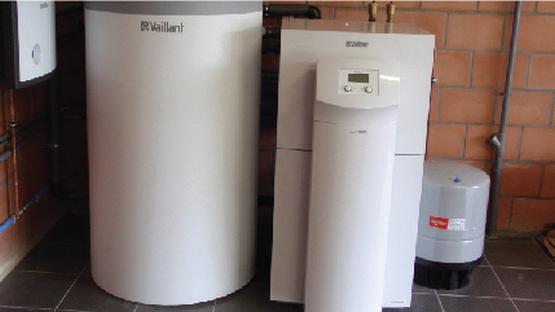What is an HP?

Amongst buildings which are sufficiently well insulated, there are many which can be heated with what are called "low temperature" systems. They guarantee an optimal comfort with boilers producing water at 40°C (instead of 60 to 75°C in the past). Three main types of boiler efficiently give this type of heating: oil, gas and heat pumps.
If gas and oil boilers are no longer to be advocated, heat pumps (HP) using geothermal energy are more innovative and offer a real alternative. They capture the calories from the subsoil by means of geothermal probes and transform them into calories able to heat buildings. A geothermal probe consists of drilling a hole into the ground in which one places a double tube permitting the heat transfer fluid to circulate and to become permeated with the heat from the subsoil. It is this energy which will then be used by the HPs.
HPs are ingenious and wonderful tools. Their size, depending on the requirements of the building, must be assessed by professionals.
Principle
The heat pump is a small boiler which enables the transformation of the calories received at low temperature into high temperature calories. The principle is simple: a fluid circulating in the HP is transformed into vapour on contact with the water coming from the geothermal probes. The gas obtained will be compressed by a compressor and will see its temperature increase (physical law). Once the required temperature has been reached, the gas transmits its heat to the water circulating in the radiators (or other heaters). Then the gas is expanded, which enables it to go back to its liquid state.... which once again will be transformed into vapour on contact with the geothermal liquid, and so on.....
In the case of geothermal energy, the HPs transform the calories received from the subsoil (about 12 °C) into calories needed for heating the building. This depends on the mode of transmission of heat to the building, either underfloor heating, or wall heating, or fan convector heating. In general, the temperature given out by HPs is around 30 to 65 °C, which allows both buildings to be heated and the production of domestic hot water.
Performance
The performance of an HP is what one calls PF. This is measured following a standard procedure. Geothermal HPs (ground - water) have a PF between 4 and 5. This indicates that for 1 kW electric energy injected into the pump (to operate the compressor), it returns between 4 and 5 kW. That is, 3 to 4 kW gained at no cost ... thanks to geothermal probes!
By way of comparison, air source HPs have a much lower PF: between 2.5 and 3. This means that these HPs will consume much more electricity.
HP manufacturers
If in the past, HPs were produced by specialist manufacturers, today the market has become sufficiently large (due particularly to Germany) that all the major brands produce very good quality, high performing and reliable HPs. Vaillant, Viessmann, Buderus, Stiebel Eltron, SDEEC, Geotherma etc. Some even give a 10 year warranty, which shows the state of development of the tool!
